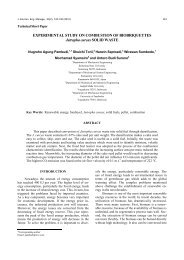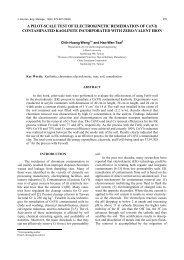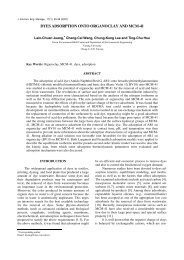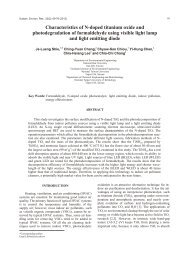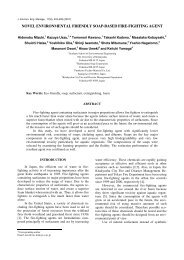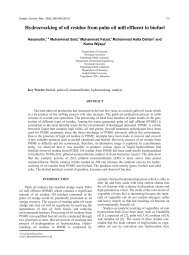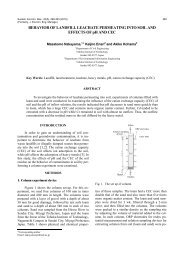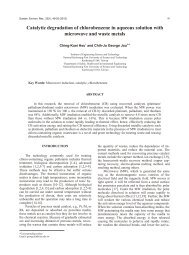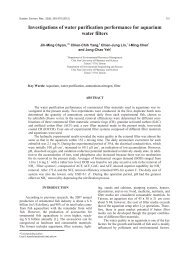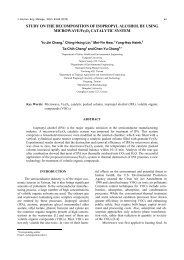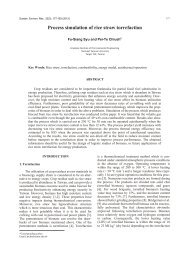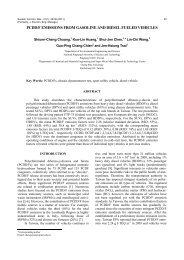Sonoleaching: Development of a rapid determination of Pb ... - SER
Sonoleaching: Development of a rapid determination of Pb ... - SER
Sonoleaching: Development of a rapid determination of Pb ... - SER
You also want an ePaper? Increase the reach of your titles
YUMPU automatically turns print PDFs into web optimized ePapers that Google loves.
378<br />
4. Preparation <strong>of</strong> the Stabilized Slag<br />
The waste sample used in this study is a slag from<br />
a <strong>Pb</strong> recovery smelting plant. The slag was pulverized<br />
to pass sieve #35 (0.5 mm). Ordinary Portland cement<br />
was used to stabilize the slag. A 1:1 ratio <strong>of</strong> slag to<br />
cement was used. 750 g <strong>of</strong> slag and 750 g <strong>of</strong> ordinary<br />
Portland cement were weighed and thoroughly mixed.<br />
Deionized water was added until a paste like consistency<br />
was obtained. The mixture was then poured into<br />
a mould and allowed to cure for 3 wk. After the curing<br />
period, the stabilized waste was then pulverized again<br />
to pass sieve #35.<br />
.<br />
5. Design <strong>of</strong> Experiment<br />
The Design-Expert 7 [30] consists <strong>of</strong> three major<br />
parts, the actual design, the analysis process and the<br />
optimization. In the actual design, the factors, parameters<br />
and expected responses considered in the study<br />
are used to determine the minimum number <strong>of</strong> runs.<br />
The response data are then used in the analysis process<br />
which includes full analysis <strong>of</strong> the variance. The optimization<br />
part determines the combination <strong>of</strong> factors<br />
and responses that simultaneously satisfy the requirements<br />
<strong>of</strong> the factors and responses.<br />
.<br />
RESULTS AND DISCUSSION<br />
A second order equation based on dissolution [31]<br />
can be expressed in the form:<br />
(1)<br />
Where k = rate constant <strong>of</strong> second order dissolu-<br />
tion, S = maximum dissolution (g), S = solubility (g),<br />
max<br />
and T = sonication time, min<br />
The equation is then linearized to:<br />
(2)<br />
Where intercept = r = initial dissolution rate =<br />
1/(k S ) and slope = reciprocal <strong>of</strong> the dissolution<br />
max<br />
equilibrium = 1/S .<br />
max<br />
The straight lines in Figs. 2a and 2b are the graphs<br />
<strong>of</strong> the linearized form <strong>of</strong> the second order dissolution<br />
equation (Eq. 2) which shows that dissolution <strong>of</strong> <strong>Pb</strong><br />
with ultrasound follows a second-order kinetics. Table<br />
2 shows the values <strong>of</strong> S , r and k for the slag and<br />
max<br />
stabilized slag as determined from the lines in Figs. 2a<br />
and 2b.<br />
.<br />
The optimization feature <strong>of</strong> the Design-Expert 7<br />
can generate a combination <strong>of</strong> solutions for optimal<br />
conditions. These are ranked in the order <strong>of</strong> desirability.<br />
Table 3 shows the optimization criteria for the<br />
<strong>determination</strong> <strong>of</strong> optimal conditions. For factors [<strong>Pb</strong>]<br />
and temperature, the criteria are the values used in the<br />
study. 30 min was chosen as the sonication time as<br />
Bellotindos et al., Sustain. Environ. Res., 21(6), 375-380 (2011)<br />
.<br />
.<br />
.<br />
.<br />
.<br />
Table 2. Dissolution rate and rate constant for extraction<br />
<strong>of</strong> <strong>Pb</strong> in slag and stabilized slag<br />
-1<br />
S max (% <strong>Pb</strong> g sample)<br />
Dissolution Rate (r)<br />
-1 -1<br />
(% <strong>Pb</strong> min g sample)<br />
t / S<br />
Rate constant (k)<br />
12<br />
10<br />
8<br />
6<br />
4<br />
2<br />
Slag Stabilized Slag<br />
31.5 12.1<br />
0.16<br />
0.0064<br />
0.05<br />
0.13<br />
0<br />
0 20 40 60 80 100 120 140<br />
Time (min)<br />
Fig. 2. Second order dissolution <strong>of</strong> <strong>Pb</strong> (a) original slag (b)<br />
stabilized slag.<br />
this was the time that equilibrium was attained during<br />
sonication. For the % <strong>Pb</strong> extraction, the value 80 was<br />
chosen as this was the average <strong>of</strong> the TCLP extractions.<br />
Of the several combinations that were generated, the<br />
conditions with comparable extraction to TLCP were<br />
sonication time <strong>of</strong> 30 min and temperature <strong>of</strong> 30 °C. .<br />
Table 3. Optimization criteria for the <strong>determination</strong> <strong>of</strong><br />
optimal conditions<br />
Factor<br />
[<strong>Pb</strong>], ppm<br />
Temperature, °C<br />
Sonication Time, min<br />
% <strong>Pb</strong> extraction<br />
CONCLUSIONS<br />
(b)<br />
(a)<br />
Criteria<br />
500-5000<br />
25-30<br />
30<br />
80<br />
Using the optimization feature <strong>of</strong> the Design-<br />
Expert 7 S<strong>of</strong>tware, the optimal conditions for an extraction<br />
comparable to TCLP are: sonication time = 30<br />
min and the ultrasonic cleaner bath temperature =<br />
30 °C. The 30 min sonication time as compared to the<br />
TCLP extraction <strong>of</strong> 18 h, means that the extraction<br />
time has been reduced by about 97% and a bath temperature<br />
<strong>of</strong> 30 °C means that the temperature can easily<br />
be obtained as it is about the ambient temperature<br />
and there is no need to monitor the ultrasonic bath until<br />
the end <strong>of</strong> the sonication. The sonoleaching <strong>of</strong> lead<br />
from slag and stabilized slag is a second order dissolution<br />
process. Extraction with the use <strong>of</strong> ultrasound did<br />
not result in chemical changes but rather physical<br />
changes occurred. The weight <strong>of</strong> the waste and the



